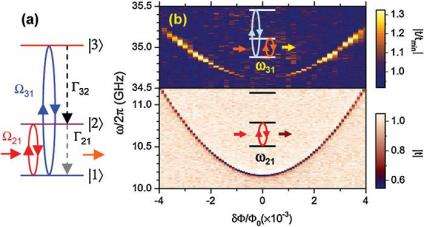May 25, 2010 feature
Physicists build quantum amplifier with single artificial atom

(PhysOrg.com) -- By demonstrating how a single artificial atom can be used to amplify electromagnetic waves, physicists from Japan are opening up new possibilities for quantum amplifiers, which can be used in a variety of electronic and optical applications.
As a device that uses quantum effects to amplify a signal, a quantum amplifier comes in many different forms. Perhaps the most well-known example is the laser, which uses the process of stimulated emission to emit photons from optically stimulated atoms. Like most quantum amplifiers, lasers use intra-atomic transitions with many atoms (or molecules) to achieve signal amplification, and the transition frequencies are not easily tunable.
One way to realize a quantum amplifier that is tunable and fully controllable is to create a system that uses only a single atom or molecule. However, single-atom quantum amplifiers have so far been very difficult to realize due to the fact that natural atoms can only be weakly coupled to the electromagnetic waves that they must amplify.
Now, researchers O.V. Astafiev and coauthors from NEC Nano Electronics Research Laboratories and RIKEN Advanced Science Institute, both in Ibaraki, Japan, have found a way to overcome this difficulty. In their new study, the researchers have demonstrated how a single artificial atom can be strongly coupled to the electromagnetic modes of open one-dimensional space, resulting in tunable and controllable electromagnetic wave amplification.
The quantum amplification is based on the ability to pump the three-state artificial atom from its ground state to the higher of its two excited states. To do this, the researchers applied microwave fields at a specific pumping frequency that propagated along a one-dimensional transmission line toward the point-like atom. The photons induced spontaneous emission from the atom, causing it to generate a scattered wave at a specific frequency, amplifying the overall signal.
“The key process is the preparation of population inversion (same as in lasers),” coauthor Abdufarrukh Abdumalikov from RIKEN told PhysOrg.com. “Our atom has three discrete energy levels. We apply a microwave which excites it from the ground state to the second excited state. From the latter the atom relaxes partly to ground state and partly to first excited state. When the population of the first excited state is larger than that of the ground state we have a population inversion. Then we apply another microwave signal which we would like to amplify. It should be in resonance with the ground state - first excited state transition. It stimulates this transition and the atom emits a photon which adds up to the signal. The principle is the same as in lasers.”
The researchers calculated the maximal gain to be about 1.09, corresponding to an average of 109 emitted photons for every 100 incident photons. Abdumalikov explained that the maximum theoretical gain is 1.125, or 112.5 emitted photons for every 100 incident photons.
Overall, the amplification by a single artificial atom provides an example of an elementary quantum amplifier, which could be used as a building block for large-scale, tunable quantum amplifiers for various applications. In addition, the demonstration of single-atom quantum amplification could open up possibilities for developing new types of on-chip quantum amplifiers and other quantum devices, which could reveal novel quantum optical phenomena due to the devices’ strong coupling, tunability and controllability.
“This is the first work of this kind,” Abdumalikov said. “If we use many atoms we can obtain larger gain. Such amplifiers can be used in other research fields where low amplifier noise is needed. One such research field is an on-chip version of cavity quantum electrodynamics (QED) that is circuit QED.”
More information: O.V. Astafiev, et al. “Ultimate On-Chip Quantum Amplifier.” Physical Review Letters 104, 183603 (2010). Doi:10.1103/PhysRevLett.104.183603
Copyright 2010 PhysOrg.com.
All rights reserved. This material may not be published, broadcast, rewritten or redistributed in whole or part without the express written permission of PhysOrg.com.
















